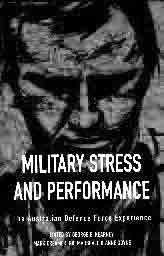Book Review
ISTSS
October 1, 2004
 Military Stress and Performance: The Australian Defence Force Experience, edited by George E. Kearney, Mark Creamer, Ric Marshall and Anne Goyne. Melbourne: Melbourne University Press, 2003. Reviewed by Jonathan Shay, MD, PhD, Boston Outpatient Clinic, Department of Veterans Affairs and the Office of the U.S. Army Deputy Chief of Staff for Personnel, Washington.
Military Stress and Performance: The Australian Defence Force Experience, edited by George E. Kearney, Mark Creamer, Ric Marshall and Anne Goyne. Melbourne: Melbourne University Press, 2003. Reviewed by Jonathan Shay, MD, PhD, Boston Outpatient Clinic, Department of Veterans Affairs and the Office of the U.S. Army Deputy Chief of Staff for Personnel, Washington.
Our colleagues from Australia have produced an excellent and useful book. Its turn of mind is practical—the perspective of military professionals in the thick of events.
The first two sections ask, during deployment into dangerous or hostile environments: What can wreck the lives of the deployed service members? What buffers and protects the mind and spirit of those we send? What nourishes resilience in the face of great stress and what bleeds it white? This first half of the book also includes chapters by a line naval commander and by a chaplain. Each of these nonclinicians, in their own way, emphasizes that self-care is not self-indulgence, but rather an irreplaceable success factor both for commander and chaplain.
The third and forth sections address early postdeployment evaluation and support for returnees, whether self-identified or noticed by others to be psychologically injured, or not injured. These sections turn a practical eye on posttraumatic stress among veterans who have left military service.
I was struck by how one chapter after another spoke respectfully of the American Psychiatric Association’s Diagnostic and Statistical Manual’s nosology and then with self-effacing candor and objectivity pointed out the DSM’s failures to capture what really wrecks the lives of military personnel and veterans. Most chapters focus on the practical and do not conceal the paucity of trustworthy, actionable knowledge in prevention and early intervention. Collectively, the chapters emphasize the importance of social factors in how things turn out, an emphasis that I applaud.
The final chapter, “Stress and the Military: What Have We Learned?” has a distressingly complacent tone, especially when contrasted to the unsparing “Psychiatric Lessons of War”—now 10 years old—by Col. Franklin D. Jones in War Psychiatry, a volume of the U.S. Army Surgeon General’s Textbook of Military Medicine. This Australian volume as a whole, however, is anything but complacent. The officers and clinicians who contributed to it demand that we do better.
Overall, this is a very worthwhile volume, but I have one more critical comment. What I am doing in the moment of writing this review, and you in the moment of reading, is, in one and the same instant, physiological, psychological, social and cultural. The authors and editors of this volume have done a good job with the latter three. But the proverbial martian reading this book would remain innocent of any existing role for early or late somatic treatments for psychological injuries and remain unaware of any actual, experimental or conjectured protective agents. As a psychiatrist who has consistently emphasized the social and ethical in both prevention and treatment, it is a novelty for me to call for more attention to pharmacology and physiology. While none of the four avatars of the human being—brain, mind, society, culture—have ontological priority over the others (one of them really real, and the others epiphenomenal), I cannot pass by without commenting that one of these embodiments has been entirely omitted from this volume.
In conclusion, I recommend the book for military professionals, including line leaders and trainers, chaplains and mental health professionals, in and out of uniform, who work directly with military forces. This book is a useful contribution to protecting our troops from psychological injury. We’re getting there, but we’re not there yet.
The reviewer, Jonathan Shay, MD, PhD, is author of Achilles in Vietnam: Combat Trauma and the Undoing of Character and Odysseus in America: Combat Trauma and the Trials of Homecoming. He is a staff psychiatrist for the Department of Veterans Affairs, and since September 1, 2004, chair of Ethics, Leadership and Personnel Policy for the U.S. Army G-1.